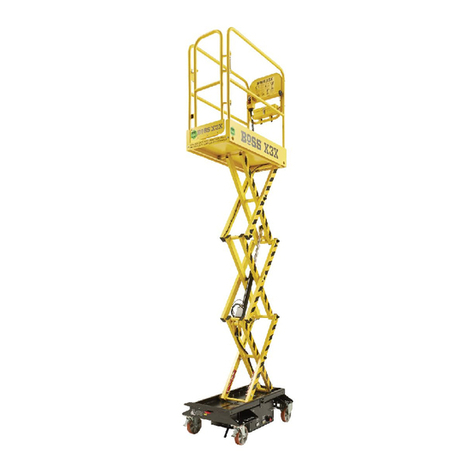XX
youngmangroup.com
BoSS Ladderspan User Guide
Stabilisers or outriggers and ballast weights shall always be
fitted when specified.
The Quantity Schedules show the recommended stabilisation.
In circumstances where there is restricted ground clearance
for stabilisers/outriggers, contact your supplier for advice.
Ballast must be of solid materials (i.e. not water or loose sand)
and should not be positioned to overload individual legs.
Ballast should be secured against accidental removal where
practicable, and be supported on the lowest rung of the
bottom frame.
MOVEMENT
The tower should only be moved by manual effort, and only
from the base.
When moving the tower, beware of live electrical apparatus,
particularly overhead, plus wires or moving parts of machinery.
No person or materials should be on the tower during
movement.
Caution should be exercised when wheeling a tower over
rough, uneven or sloping ground, taking care to unlock and
lock castors. If stabilisers are fitted, they should only be lifted
a maximum of 25mm above the ground to clear ground
obstructions.
The overall height of the tower when being moved, should not
exceed 2.5 times the minimum base dimensions, or 4 metres
overall height.
Before use, check the tower is still correct and complete.
After every movement of the tower use a spirit level to check
that it is vertical and level and set the adjustable legs as
required.
Do not move the tower in wind speeds over 7.7 metres per
second (17mph).
Beware of high winds in exposed, gusty or medium breeze
conditions. We recommend that in wind speeds over 7.7 metres
per second (17 mph), cease working on the tower and do not
attempt to move it. If the wind becomes a strong breeze,
expected to reach 11.3 metres per second (25 mph), tie the
tower to a rigid structure. If the wind is likely to reach gale
force, over 18 metres per second (40 mph), the tower should be
dismantled.
Wind
Description Beaufort Scale Beaufort
No. Speed
in m.p.h Speed
in m/sec
Medium
Breeze
Raises dust and
loose paper,
twigs snap off
4 8-12 4-6
Strong
Breeze
Large branches
in motion,
telegraph wires
whistle
6 25-31 11-14
Gale Force Walking is
difficult 8 39-46 17-21
Beware of open ended buildings, which can cause funnelling
effect.
Do not abuse equipment. Damaged or incorrect components
shall not be used.
Raising and lowering components, tools, and/or materials by
rope should be conducted within the lower base. Ensure that
the safe working load of the supporting decks and the tower
structure is not exceeded.
The assembled tower is a working platform and should not be
used as a means of access or egress to other structures.
Beware of horizontal forces (e.g. power tools) which could
generate instability. Maximum horizontal force 20 kg.
The stairway towers, featuring an inclined staircase access, are
for frequent use by personnel carrying tools and/or materials.
Mobile towers are not designed to be suspended - please
refer to your supplier for advice.
Do not use boxes or stepladders or other objects on the
platform to gain extra height.
Safety First
STABILISERS / BALLAST
3
DURING USE
Safety First
4
Safety First
TIES
5
Ties should be used when the tower goes beyond its safe
height, beyond the limits of the stabilisers/outriggers, or if
there is a danger of instability. They should be rigid, two way
ties fastened to both uprights of the frame with load-bearing
right angled or swivel couplers. Only couplers suitable for the
50.8mm diameter tube of the tower should be used. Ideally,
ties should be secured to both faces of a solid structure by
means of anchorages.
The tie frequency may vary depending on the application, but
they should, at a minimum, be every 4 metres height.
For further information on tying-in a tower please contact your
supplier or Youngman.
MAINTENANCE - STORAGE - TRANSPORT
All components and their parts should be regularly inspected
to identify damage, particularly to joints. Lost or broken parts
should be replaced, and any tubing with indentation greater
than 5mm should not be used and put to one side for
manufacture repair. Adjustable leg threads should be cleaned
and lightly lubricated to keep them free running.
Brace claws, frame interlock clips, trapdoor latches and
platform windlocks should be regularly checked to ensure they
lock correctly.
Refer to the BoSS Inspection Manual for detailed inspection
and maintenance advice
Components should be stored with due care to prevent
damage.
Ensure components are not damaged by excessive strapping
forces when transported.































